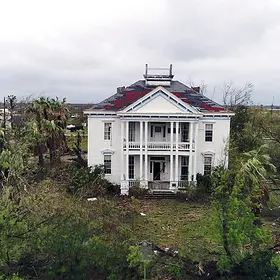.webp)
How to Prepare for the Next Natural Disaster
No matter the impending weather, it's always important to make sure you are prepared for disaster-related damage. A historic property is no different from the average home, and it often needs extra protection to prevent or reduce further damage. The checklist below is an excellent way to ensure your historic home is protected from major storms and hurricanes.
1 Inspect the roof for problems with:
- Roof covering.
- Flashing or edging strips.
- Blocked drains, gutters, or downspouts.
- Inadequately secured equipment, stacks, roof ventilators, and other additions.
2 Relocate important outdoor machinery and stock indoors, or securely fasten it down. Anchor outdoor structures, such as trailers.
3 Board up all large windows subject to possible breakage. Inspect doors and windows for weak latches or hardware, and make needed repairs to prevent further damage.
4 Prepare for possible flooding. Obtain sandbags, if necessary, for placement at vulnerable building openings.
5 Fill your emergency generator and fire pump fuel tanks. Fill above-ground tanks at capacity with product or water to prevent wind or flood damage.
6 Back up all important computer data and protect important records from possible wind, debris, and water damage.
7 Inspect all fire protection equipment, such as sprinkler valves, fire extinguishers, and fire pumps to verify they are in good working condition.
8 Assemble the following equipment and supplies at a central, secure location:
- Emergency lighting such as flashlights. Do not use candles or kerosene lamps.
- Battery-operated radio.
-Tarpaulins.
- Tape for windows.
- Lumber and nails.
- Sandbags.
- Names and telephone numbers of important contacts, including insurance claims information.
- Hand tools such as shovels, axes, mops, and squeegees.
9 If necessary, safely:
- Shut off all flammable liquid and gas lines at their source to prevent discharge.
- Shut off your building’s electrical power when it is in eminent danger of flooding.
- Enforce “no smoking” and “no cutting or welding” rules.
Disaster Recovery: How to Protect Your Historic Property

These tips can reduce or prevent problems for your historic property—and protect your wallet from erroneous charges.
Of course, we can’t prevent all damage and before disaster hits. There's no better time than the present to review your insurance coverages in order to understand what your policy will cover, and what is excluded. For more information on proper coverage for historic properties, contact National Trust Insurance Services, LLC. As a subsidiary of the National Trust for Historic Preservation, National Trust Insurance Services is a resource to clients and members alike.
A version of this story was published on 1/17/2018.


